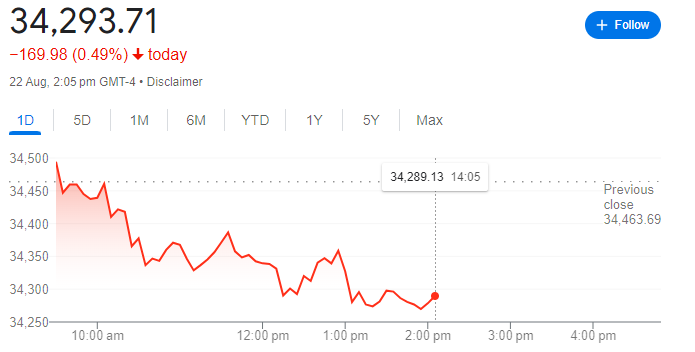In the ever-evolving landscape of global financial markets, indices play a pivotal role in providing investors with insights into the performance and trends of various sectors and industries. One such influential index is the IndexDJX: .DJI, more commonly known as the Dow Jones Industrial Average (DJIA). As one of the most recognized and followed stock market indices in the world, the DJIA serves as a barometer of the overall health and direction of the U.S. stock market.
Origin and Historical Significance
The history of the DJIA dates back to the late 19th century, making it one of the oldest and enduring indices in existence. Charles Dow, along with his partner Edward Jones, published the first iteration of the index on May 26, 1896. The original index consisted of just 12 stocks, primarily representing the industrial sector of the U.S. economy at that time.
Charles Dow’s vision behind creating the DJIA was to provide investors and the public with a simple and intuitive measure of market performance. The index’s construction was straightforward: it was a price-weighted average of the selected stocks. This meant that the stocks with higher prices had a more significant impact on the index’s movements.
Evolution and Composition
Over the decades, the DJIA has undergone several transformations to reflect the changing dynamics of the U.S. economy. The most significant changes include adjusting the number of component stocks, diversifying the sectors represented, and modifying the calculation methodology.
Initially comprising only 12 stocks, the DJIA expanded to its current composition of 30 stocks, offering a more comprehensive snapshot of the market. While the index’s historical focus was on industrial stocks, the modern DJIA includes companies from various sectors, including technology, finance, healthcare, and consumer goods.
Significance and Impact
The IndexDJX: .DJI is more than just a collection of numbers; it holds significant implications for investors, economists, policymakers, and the public at large. The index is often considered a reflection of investor sentiment, economic health, and market trends. A rising DJIA is generally seen as a positive indicator of market optimism, while a declining index may indicate underlying concerns or uncertainties.
Moreover, the DJIA’s movements can influence investor behavior, portfolio management strategies, and even international financial markets. Many exchange-traded funds (ETFs) and other financial products are based on the performance of the DJIA, making it a key reference point for investment decisions.
Methodology and Calculation
The methodology used to calculate the DJIA has evolved to adapt to the changing dynamics of the stock market. While the Dow Divisor was a significant improvement over the original price-weighted method, the index is still not entirely immune to criticism. Detractors argue that the index’s calculation doesn’t take into account factors like market capitalization, which is a commonly used metric for other indices like the S&P 500. As a result, stocks with higher prices still have a more substantial impact on the index’s value, which can lead to distortions.
The formula for calculating the DJIA involves adding up the stock prices of its components and then dividing the total by the Dow Divisor. The Divisor is adjusted periodically to account for changes in the stock market landscape. This adjustment prevents sudden changes, such as stock splits, from disproportionately affecting the index’s value.
Current Composition and Representation
As of its last update, the DJIA is comprised of 30 blue-chip companies, each selected for their significance and impact on the U.S. economy. The components are periodically reviewed and changed by the index committee to ensure that the DJIA remains a relevant representation of the market.
The index’s composition spans various sectors, including technology, healthcare, finance, consumer goods, and more. This diversity is intended to provide a holistic view of the U.S. economy, though some critics argue that the index still skews towards a few industries and might not accurately represent the broader market landscape.
Investment Strategy and Market Influence
The DJIA has far-reaching implications for investment strategies and financial markets. It serves as a benchmark against which individual stock performance and investment portfolios are often measured. Many investors use the DJIA’s movements as a gauge to assess market sentiment and potential trends. Additionally, financial products like index funds and ETFs track the DJIA’s performance, allowing investors to gain exposure to the overall market without investing in every individual component.
Furthermore, the index’s movements can influence investor behavior, potentially driving buying or selling trends. A sharp increase or decrease in the DJIA might trigger market reactions as investors adjust their positions accordingly. Additionally, international markets often respond to changes in the DJIA, as it is seen as an indicator of the health of the U.S. economy, which holds a significant impact on global financial stability.
Limitations and Criticisms
While the DJIA is widely followed and respected, it is not without its limitations. One of the main criticisms is its price-weighted methodology, which can lead to distortions when higher-priced stocks experience significant fluctuations. Additionally, the index’s relatively small number of components might not provide as comprehensive a view as other broader indices like the S&P 500.
Furthermore, the exclusion of certain industries or companies from the DJIA can result in an incomplete representation of the economy. For instance, the index might not fully capture the growth and significance of smaller or newer sectors that have emerged in recent years.
Conclusion
The IndexDJX: .DJI, or the Dow Jones Industrial Average, holds a venerable position in the world of financial markets. Its long history, evolution, and influence on investor sentiment and behavior make it a cornerstone of modern finance. However, investors and analysts alike must be aware of its calculation method, composition, limitations, and the broader economic context when interpreting its movements. As we continue to navigate the complexities of the global economy, the DJIA will undoubtedly remain a central reference point for gauging market performance and trends.










































